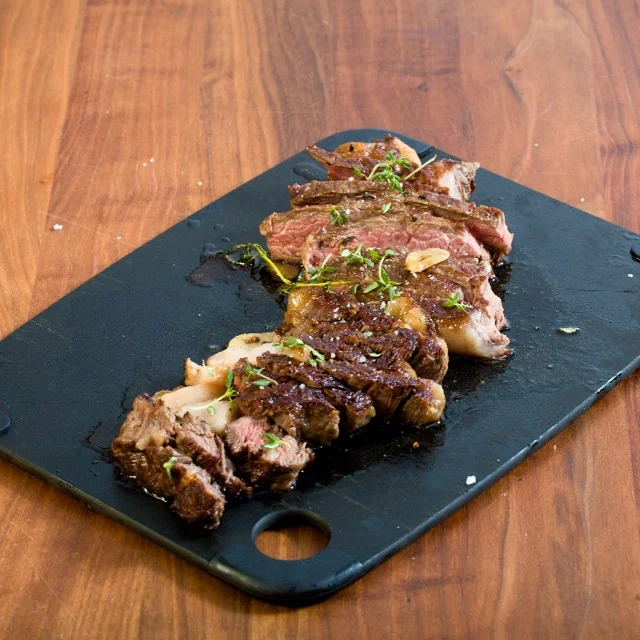Croissants are made from a yeasted dough laminated with butter. It is so so good.
The trick is to keep the dough and the butter at the same temperature and texture, to prevent soft butter bleeding out of the dough. A too cold dough will crack a bit, so you are looking for a firm but yet soft dough.
There are different kinds of folding/turning when it comes to pastry and croissant dough.
Letter fold or Single turn: Dough folded in thirds, like you would do a letter going into an envelope. (I did that for this recipe.)
1. Turn: makes 3 layers of butter
2. Turn: makes 9 layers of butter
3. Turn: makes 27 layers of butter.
Book fold or double turn: Dough folded to the middle and folded again on the middle like a book. This makes 4 layers per fold or turn as they are called.
1. Turn: makes 4 layers of butter
2. Turn: makes 16 layers of butter
3. Turn: makes 64 layers of butter
You can mix the folding methods to get the amount of layer you want. Theoretically you can make how many layers you want, but making too many layers makes you end up with a brioche dough, made the hardest way possible 😉.
At the croissant class I attended I learned that Manresa Bread use 2 double turns (16 layers) for regular croissants, and 3 single turns (27 layers) for chocolate croissants. For traditional Danish pastry you normally use 3 single turns, giving the desired 27 layers of butter. If you are looking for a traditional puff pastry, you need 144 layers
Makes this 20-24 croissants.
Ingredients:
Dough/Détrempe:
750 g bread flour
200 g water, lukewarm
187.5 g milk
90 g sugar
22.5 g salt
65 g live yeast (15 g dry yeast)
7.5 g malt powder
37.5 g butter, room temperature
Beurrage (butter):
450 g cold butter
all-purpose flour for dusting
Directions:
Dough/Détrempe:
Mix the milk with the water, dissolve the yeast in this mixture. Add the sugar. If using dry yeast, let the yeast wake up for about 5-10 minutes, until creating a foam on top.
Mix in half of the flour and malt powder, forming a sticky dough. Mix in the softened butter. Finally mix in the rest of the flour and knead the dough until you have a shiny, slightly sticky and elastic dough, for about 3-5 minutes. The dough will be a bit on the dry/tough side.
Shape dough into a ball and place it in a dough rising bucket, or another large covered container. Let the dough fermented overnight, this will give you a good flavor.
Beurrage (butter):
Place the cold butter on a well floured surface. With your palms press the butter a little flat. Using a rolling pin pound on the butter to flatten it. Fold the butter into it self, and keep pounding and folding until the butter has the same consistency as the dough. You want to end up with a 30x32 cm (11x12.5 inch) sheet of soft but still cold butter. If the butter is too warm or too hard, it will be hard to roll it out in the dough, and it might make holes in the dough, instead of the lamination.
If you don't want to add any flour to your butter, you can pound and roll out the butter between sheets of parchment paper. Chill the butter while you roll out the dough.
Laminating:
Place dough on a lightly floured surface, roll it out to 62x32 cm (24.5x12.5 inch), so the dough is the width of the butter, but a little over double in length. Clearly I rolled my dough longer than necessary, but it worked fine anyway. Place the butter on the dough, and wrap it with the dough, pinching the edges, meeting in the middle of the dough, together. Chill the dough package covered in the refrigerator for about 15-20 minutes, before starting the folding/turning.
Roll the dough to a rectangle, 3-4 times as long as the height. Keep it lightly floured so the dough do not stick to the surface. Make sure to roll the dough with straightedges. This will ease the folding.
Fold the far edges into the middle and fold again on the middle like a book. Now you have 4 layers of butter. Place the covered dough in the freezer for about 20 minutes to cool the butter again, and to relax the gluten.
Repeat this one more time, making 2 double (book) turns and ending up with 16 layers of butter. If you want to use this dough for Danish pastry or chocolate croissants, I would make 3 single turns, so you end up with 27 layers.
Before shaping the croissants you want the dough to rest covered in the refrigerator for at least 45-60 minutes. And letting it sit covered for 5 minutes on the kitchen counter, letting the butter to soften up a bit.
Shaping the croissants:
Roll half the dough out to a 20x40 cm (8x16 inch) rectangle. Using a knife or pizza slicer to cut the dough. Cut the croissant triangles as shown in the picture. (you get 7, not 5 croissants from the dough, I missed the last 2 in the picture, sorry). Let the dough rest covered 5 minutes to relax the gluten a bit.
Stretch the triangle, so you elongate it, be careful not to rip the dough. Roll the dough towards the tip of the triangle, making sure that the tip is on the underside of the croissant.Place the croissant on a parchment paper lined baking sheet, spaced at least 5 cm (2 inch) apart.
Proof the croissant covered at maximum 85℉ (29.5℃) for 45-60 minutes until doubled in size. I have a proof setting on my oven, so I can use that, with a cup of boiling water sitting next to the baking sheet. But you can also proof the croissant on the kitchen counter, in a large air filled plastic bag.
Presheat oven to 350℉ (177℃) convection or 375℉ (190℃) foer non-convection.
Gently brush the croissants with egg wash, covering the exposed surfaces not allowing the egg wash to drip or pool.
Bake the croissants for 15-20 minutes, until golden brown. Let the croissants on the baking sheet on the kitchen counter.
Serve the croissants within a day.
Enjoy!
Tip:
The unbaked pastry can be frozen just, after shaping, individually, and can be baked straight out of the freezer, just add about 5 more minutes to the baking time.
Tip:
Leftover croissants can be used for almond croissants. Make some frangipan (125 g almond flour, 125 g butter, 125 g powdered sugar, 12 g all-purpose flour and 1 large egg, all mixed together) and smear it inside the croissant, and on top, before baking it for xx minutes.









